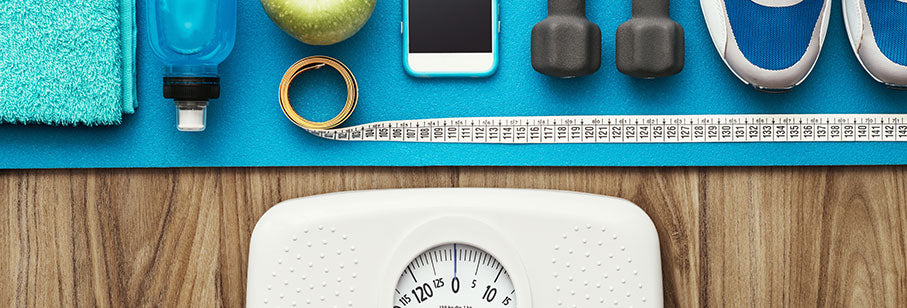Fat loss is not rocket science. However, some infomercials will have you believe that losing body fat is some sort of weird science based on many complex, secretive principles that only a few enlightened ones have access to: “You too, can have access to this information! Just pay the three small installments of $49.95!”
If you’re confused about how to lose body fat, please don’t feel bad; many years ago, I was in your shoes too. Because of that, I will share with you my 8 Fat Loss Directives. These directives are 8 simple rules that will help you start losing body fat now.
The 8 Fat Loss Directives
I am going to program you now with eight fat loss directives that when followed will allow you to achieve fat loss along with increased muscle tone.
Fat Loss Directive #1: Consume less calories than your body burns. Do this for six days a week.
You want to consume approximately 500 calories less than what your body normally burns in one day (maintenance number of calories.) If you do not create a caloric deficit, no matter what you do, you will not lose fat!
However, it is important that once per week, you increase your calories by 500-700 over the maintenance amount. This will help your metabolism from slowing down.
Fat Loss Directive #2: Track your progress by taking pictures and tape measurements of your waist size. Do not go by the weight scale alone.
Be more concerned with the way you look in the mirror (or in pictures) and your waist size, rather than with your total body weight on the scale. Scale weight does not distinguish between the amount of fat and muscle that you have.
Most of the time, athletes who are just starting out tell me that they need to lose anywhere between 20-40 pounds of fat. However, I would not be nearly as concerned with the weight as I would be with the way you look in pictures and your waist size.
The reason for that is the fact that as you begin your weight training you will start gaining lean muscle and as a result, even if you lose fat, the scale may not show any weight difference. Therefore, stop obsessing about your weight and just concern yourself with the way you look, plus your waist size.
Fat Loss Directive #3: Concentrate on weight training, not cardio, for losing fat.
Yes, you heard right. Even though I constantly hear the line “I will lose the fat first by only doing cardio and then gain lean muscle after all of the fat is gone”, this is not the best way to lose fat! Cardio only burns calories while you perform the activity, while weight training keeps your metabolism revved higher for up to 48 hours!
In addition, only weight training can permanently increase your metabolic rate, since for every pound of muscle you gain, you will burn extra calories. In addition, using cardio as your sole source of exercise will lead to losing equal amounts of fat and muscle. The end result will be a “smaller but still fat” version of yourself with a slower metabolism (due to the muscle loss). Gaining lean muscle is really the secret to long term fat loss, as the more muscle you have, the more calories you burn at rest on any given day.
In addition, gaining muscle is the key to achieving the firm, good-looking body that everybody wants. Dieting and cardio alone will not give you that. Note: I included a fast-paced Fat Burning Workout for you to use at the end of this article.
Fat Loss Directive #4: Add some cardio activity 3-4 times a week for 30 minutes, first thing in the morning on an empty stomach.
Performing your cardiovascular activity first thing in the morning on an empty stomach always results in the quickest fat loss results. The reason for this is that due to the overnight fast, your body has to rely on burning its stored fats for fuel. If you have trouble waking up, a cup of coffee can really help to get your metabolism and energy systems going first thing in the morning. The caffeine in the coffee will help maximize fat loss and protect muscle during exercise!
Fat Loss Directive #5: Eat smaller more frequent meals throughout the day.
The first thing that most dieters do is start a “crash diet” where they only eat once or twice a day, as well as increasing cardiovascular activity. Again, this is a sure-fire way to lose muscle and lower your metabolism. As we already know, less muscle and slower metabolism is not the way to get to your physique goal.
In order to keep the metabolism going at full speed and the blood sugar levels under control (which keeps energy levels high and cravings away), eating 5 to 6 small balanced meals a day is the way to go. When I say balanced meals, what I mean is that each meal should contain all of the macronutrients (carbs, protein and fats) in a specific ratio.
While metabolisms differ, I have found that a ratio of 40-45% Carbs, 40-35% Protein, and no more than 20% Fats is generally the best way to go. This ratio is optimal for keeping insulin and blood sugar under perfect control. In addition, this ratio creates a favorable hormonal environment that leads to muscle growth and fat loss.
While 5-6 meals sound intimidating, not all of your meals have to be real food. If you have 5 meals, your mid-morning and mid-afternoon meals can consist of a Lean Body Meal Ready-to-Drink Shake plus a small piece of fruit.
Fat Loss Directive #6: Let water be your main beverage.
Time and time again I have noticed that dieters start their diets with a sincere effort and even count all the calories of the foods that they consume. However, most totally forget about the fact that fruit juices, sodas and other beverages contain calories as well. Therefore, avoid any type of drink that contains calories and concentrate on drinking plain water instead.
By doing this you will get the following benefits:
• Your appetite will be suppressed as water helps control your appetite. Sometimes when you feel hungry after a good meal this sensation indicates a lack of water. Drinking water at that time would take the craving away.
• You will get a metabolic boost as cold water increases your metabolism.
• The fat loss process will be operating a full peak as water is needed in order for fat loss to occur.
• You will not be drinking unnecessary calories as water has no calories.
Fat Loss Directive #7: Be prepared and pack your meals in advance.
One thing that can kill the best diet plans is going to work each day. Work, however, is not the culprit. The culprit is the lunch hour. If the dieter does not pre-pack his/her food, lunch comes along and the person ends up going to the nearest fast-food restaurant and exposing themselves to temptation that probably nine out of ten times they succumb to.
Therefore, the best way to stay on the diet (and also avoid losing meals) is to pre-pack everything in such a way that when mealtime comes, it is relatively easy to have access to the food. Another advantage of this is that since the food is pre-packed, you will not be adding extra food to the plate. For more ideas about how to prepare and pack your meals, be sure to download our free Lean Body Fitness App.
Fat Loss Directive #8: Go to Bed Early.
Two reasons for this:
1. Lack of sleep increases the hormone cortisol, which is a hormone that stores fat and burns muscle (in other words, it does the exact opposite of what you are trying to accomplish), and decreases your testosterone levels (which need to be higher in order to keep your fat burning/muscle gaining processes going at full speed). While sleep requirements vary, seven to nine hours of sleep is generally a good rule of thumb.
2. The probability of succumbing to late-night cravings increases exponentially for every late hour of the day that you stay awake.
Sample Fat Burning/Muscle Building Meal Plan Diet for Males
Cardio: 30 minutes of cardio (6:00 am)
Meal 1 (7:00 am)
1 cup of oatmeal
1 piece of fruit such as an apple
10 egg whites
½ tablespoon of fish oil
Supplements: Multiple Vitamins/Minerals, Vitamin C (1000 mg)
Meal 2 (10:00 am)
Lean Body RTD with 1 cup of oatmeal or rice cakes
Meal 3 (12:30 pm) 1 cup of brown rice
Serving of vegetables such as green beans, broccoli, asparagus 5 ounces of chicken
Supplements: Vitamin C (1000 mg)
Meal 4 (3:00 pm) Lean Body RTD with 1 cup of oatmeal or 7 rice cakes
Meal 5 (5:30 pm)
8 ounces of baked potatoes
Serving of vegetables such as green beans, broccoli, asparagus 8 ounces of tilapia
½ tablespoon of fish oil
Supplements: Vitamin C (1000 mg)
Meal 6 (9:00 pm)
1/2 cup oatmeal
½ cup of low-fat cottage cheese
Water Intake: Drink your bodyweight x 0.66 in ounces of water throughout the day. Your body is mostly composed of water so if you do not drink your daily requirement you may be jeopardizing your muscle gains and also not letting your body get rid of the toxins and waste produced by all of the physical activity efficiently.
Sample Fat Burning/Toning Meal Plan for Females
Cardio: 30 minutes of cardio (6:00 am)
Meal 1 (7:00 am)
1/2 cup of oatmeal 1 piece of fruit such as an apple
5 egg whites 1 teaspoon of fish oil
Supplements: Multiple Vitamins/Minerals, Vitamin C (1000 mg)
Meal 2 (10:00 am)
Lean Body RTD
Meal 3 (12:30 pm) 1/2 cup of brown rice Serving of vegetables such as green beans, broccoli, asparagus 3 ounces of chicken
Supplements: Vitamin C (1000 mg)
Meal 4 (3:00 pm)
Lean Body RTD
Meal 5 (5:30 pm)
4 ounces of baked potatoes
Serving of vegetables such as green beans, broccoli, asparagus 4 ounces of tilapia
1 teaspoon of fish oil Supplements: Vitamin C (1000 mg)
Meal 6 (9:00 pm)
1/2 cup oatmeal
½ cup of low-fat cottage cheese
Water Intake: Drink your bodyweight x 0.66 in ounces of water throughout the day. Your body is mostly composed of water so if you do not drink your daily requirement you may be jeopardizing your muscle gains and also not letting your body get rid of the toxins and waste produced by all of the physical activity efficiently.
Conclusion
Now that you have been programmed with all of the Fat Loss Prime Directives, it is time to put them to good use so that you can get lean in no time!
Take care and train hard!
Please Let Us Know If You Enjoyed This Article.
Your Feedback Is Important To Us
Disclaimer: This content is for informational purposes only and is not meant as medical advice, nor is it to diagnose or treat any medical condition. Please consult your physician before starting or changing your diet or exercise program. Any use of this information is at the sole discretion and responsibility of the user.













